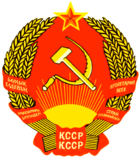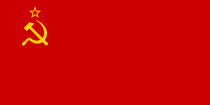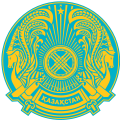Kazakh Soviet Socialist Republic
| Қазақ Кеңестік Социалистік Республикасы (Kazakh) Казахская Советская Социалистическая Республика (Russian) Kazakh Soviet Socialist Republic |
|||||
|
|||||
|
|||||
 |
|||||
| Capital | Alma-Ata (today Almaty) | ||||
| Official language | None (Kazakh and Russian) | ||||
| Established In the Soviet Union: - Since - Until |
August 26, 1920 December 30, 1922 December 16, 1991 |
||||
| Area - Total - Water (%) |
Ranked 2nd in the USSR 2,717,300 km² 1.7% |
||||
| Population - Total - Density |
Ranked 4th in the USSR 16,711,900 6.1/km² |
||||
| Time zone | UTC + 4 to + 6 | ||||
| Anthem | Anthem of the Kazakh Soviet Socialist Republic | ||||
| Medals | |||||
The Kazakh Soviet Socialist Republic (Kazakh: Қазақ Кеңестік Социалистік Республикасы, Qazaq Keñestik Socïalïstik Respwblïkası; Russian: Казахская Советская Социалистическая Республика, Kazakhskaya Sovetskaya Sotsialisticheskaya Respublika), also known as the Kazakh SSR for short, was one of republics that made up the Soviet Union. At 2,717,300 square kilometres (1,063,200 square miles) in area, it was the second largest constituent republic in the USSR, after the Russian SFSR. Its capital was Alma-Ata (today known as Almaty). Today it is the independent state of Kazakhstan in Central Asia. During its existence it was led by the Communist Party of the Kazakh SSR.
The country is named after the Kazakh people, Turkic-speaking former nomads who sustained a powerful khanate in the region before Russian and then Soviet domination. The Soviet Union's spaceport, now known as the Baikonur Cosmodrome was located in this republic at Tyuratam, and the secret town of Leninsk was constructed to accommodate its personnel.
Contents |
History
Established on August 26, 1920, it was initially called Kirghiz ASSR (Kirghiz Autonomous Soviet Socialist Republic) and was a part of the Russian SFSR. On April 15-19, 1925, it was renamed Kazak ASSR (subsequently Kazakh ASSR) and on December 5, 1936 it was elevated to the status of a Union-level republic, Kazakh SSR. During the 1950s and 1960s Soviet citizens were urged to settle in the Virgin Lands of the Kazakh Soviet Socialist Republic. The influx of immigrants, mostly Russians, skewed the ethnic mixture and enabled non-Kazakhs to outnumber natives. As a result, the use of Kazakh language has declined but has started to pick up again after the independence, both as a result of its resurging popularity in law and business and growing proportion of Kazakhs since the Independence. The other nationalities included Ukrainians, Germans, Jews, Belarusians, Koreans and others; Germans at the time of independence formed about 8% of the population, the largest concentration of Germans in the entire Soviet Union. Independence has caused many of these newcomers to emigrate. On December 10, 1991 Kazakh SSR was renamed into Republic of Kazakhstan and fifteen days later became independent, with the final collapse of the Soviet Union.
Population
According to the 1897 census, the earliest census taken in the region, Kazakhs constituted 81.7% of the total population (3,392,751 people) within the territory of contemporary Kazakhstan. The Russian population in Kazakhstan was 454,402, or 10.95% of total population; there were 79,573 Ukrainians (1.91%); 55,984 Tatars (1.34%); 55,815 Uyghurs (1.34%); 29,564 Uzbeks (0.7%); 11,911 Mordovans (0.28%); 4,888 Dungan (0.11%); 2,883 Turkmen; 2,613 Germans; 2,528 Bashkir; 1,651 Jews; and 1,254 Poles.
Table: Ethnic Composition of Kazakhstan (census data)[1]
| Nationality | 1959 % | 1970 % | 1979 % | 1989 % | 1999 % |
|---|---|---|---|---|---|
| Kazakh | 30.0 | 32.6 | 36.0 | 40.1 | 53.4 |
| Russian | 42.7 | 42.4 | 40.8 | 37.4 | 29.9 |
| Ukrainian | 8.2 | 7.2 | 6.1 | 5.4 | 3.7 |
| Belarusian | 1.2 | 1.5 | 1.2 | 1.1 | 0.8 |
| German | 7.1 | 6.6 | 6.1 | 5.8 | 2.4 |
| Tatar | 2.1 | 2.2 | 2.1 | 2.0 | 1.7 |
| Uzbek | 1.5 | 1.7 | 1.8 | 2.0 | 2.5 |
| Uyghur | 0.6 | 0.9 | 1.0 | 1.1 | 1.4 |
| Korean | 0.8 | 0.6 | 0.6 | 0.6 | 0.7 |
References
- ↑ www.ohchr.org/english/issues/minorities/docs/WP5.doc
External links
- Kazakhstan: Seven Year Plan for Prosperity by Dinmukhamed Konayev, a 1958 Soviet propaganda booklet
|
||||||||||||||
|
|||||||||||||||||||||||||||||||||||||||||||



